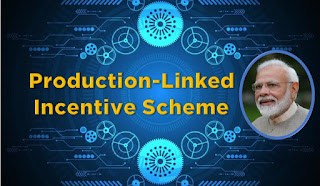PRODUCTION LINKED INCENTIVE SCHEME: A STEP FORWARD TOWARDS, BHARAT
The union cabinet approved the Production Linked Incentive (PLI) scheme for 10 sectors on 11th November 2020. These are pharmaceutical, automobiles and auto components, telecom and network products, advanced chemistry all-battery, textiles, food products, solar modules, white goods, and specialty steel. The Ministry of Electronics and information technology (Meity) introduced the PLI scheme and at least 22 companies including tech giants Samsung, Apple, and Flex have applied for the incentive-based scheme. The government of India seeks to boost Make in India initiative to make the country a manufacturing and export hub for mobile phones. In order to reduce India’s dependence on China, the government in March announced a scheme that aims to give companies incentives for incremental sales from products manufactured in domestic units.

FEATURES
The objective of this scheme is to make Indian manufacturers globally competitive. This scheme will also help in job creation. PLI scheme focuses on incentivizing firms to grow fast, boosting India’s manufacturing and export prospects. But in the long run, sectors need to die and be born. The scheme invites foreign companies to set up units in India, however, it also aims to encourage local companies to set up or expand existing manufacturing units. The scheme aimed at increasing India’s global share of India’s medical devices and pharmaceuticals market. While reducing India’s import dependence on medical devices and critical APIs (Active Pharmaceutical Ingredient). The government would extend an incentive of 5% on incremental sales of goods manufactured in India covered under the target segments to eligible companies for a period of five years. The scheme will contribute significantly to achieving a USD 1 trillion digital economy and a USD 5 trillion GDP by 2025. The scheme envisages globally-integrated manufacturing in sectors such as automobile and auto components, pharmaceuticals, telecommunications, white goods, and steel. The scheme aims to improve core competencies and attract investment in cutting-edge technology to foster innovations across those sectors to make manufacturing globally competitive.
PROCEDURE OF THE PLI SCHEME
All electronic manufacturing companies which are Indian or have a registered unit in India will be eligible to apply for the scheme. These companies can either create a new unit or seek incentives for existing units in one or more locations in India. Eligibility under the PLI scheme shall not affect eligibility under the schemes and vice-versa. The eligibility is subjected to cumulative fulfillment of the prescribed threshold limits in relation to the increment and incremental sale of manufactured goods. The international mobile phone manufacturing companies that have applied under the mobile phone (invoice value INR 15000 and above) segment are Samsung, Foxconn Hon Hai, Rising Star, Wistron, and Pegatron. This scheme is expected to increase their manufacturing base manyfold in the country. The PLI scheme will be active for five years with the financial year (FY) 2019-20 considered as the base year for the calculation of incentives. This means that all investment and incremental sales registered after FY20 shall be taken into account to be given to each company. For the First Year, the total incentive to be given has been capped at Rs 5,334 crore, while for the second and third years, it has been kept at Rs 8,064 and Rs 8,425 crore respectively. In the fourth year, the incentive will be hiked substantially to Rs 11,488 crore, while in the fifth and final year, the incentive to be distributed has been capped at Rs 7,640 crore. The total incentives over five years have thus been kept at Rs 40,951 crore.

DRAWBACKS
It is not as easy as it looks. Subsidies granted by the Indian government have been a matter of international dispute and are therefore to be examined closely. For instance, in 2019, India lost a case before the World Trade Organisation (WTO) where several incentive schemes such as MELS, EPCG, and SEZ were challenged on the ground that such export-linked schemes violate international trade agreements between member countries. While India’s appeal is pending, it is imperative to note that while the scheme challenged before the WTO was export linked and did not fall foul of the international trade agreement. On the other hand, if one company underperforms but another company over-performs in terms of its net incremental sales, then any unappropriated incentive amount will be transferred proportionately to the over-performing companies.
FUTURE
The PLI scheme is expected to fuel the overall manufacturing ecosystem in India for telecom and networking gear, components as well as tech products, and its strategic timing places the country in the “great position” for the future, a senior official of Qualcomm said. “We have seen unprecedented financial support to the sector in the current single calendar year. It is for the first time, the government is pouring in something like USD 1 billion which will be available to the sector over the next five years. This fiscal support extends to the establishment of infrastructure in the form of medical device parks. The government has also launched a production-linked incentive scheme for medical devices, which has received a positive response. The government is also supporting scientific projects engaged in energy Research which will help India in becoming a world leader in this sector in the coming years.
CONCLUSION
If this scheme goes through precise planning and execution, it could become one of the most vital initiatives that have been adopted in our country. The manufacturing sector of the country is set to transform in the next few years and its contribution to the GDP will significantly improve. Our producer would certainly get the push to the domestic demand and foreign firms would be encouraged to invest heavily in India. The citizens of India would obtain more employment opportunities as well. It is a win-win situation for all the parties that would be involved.

